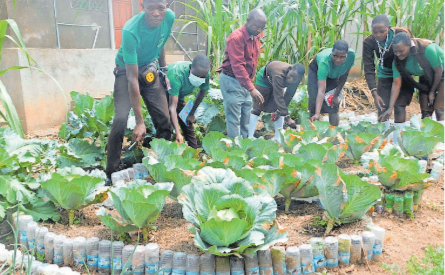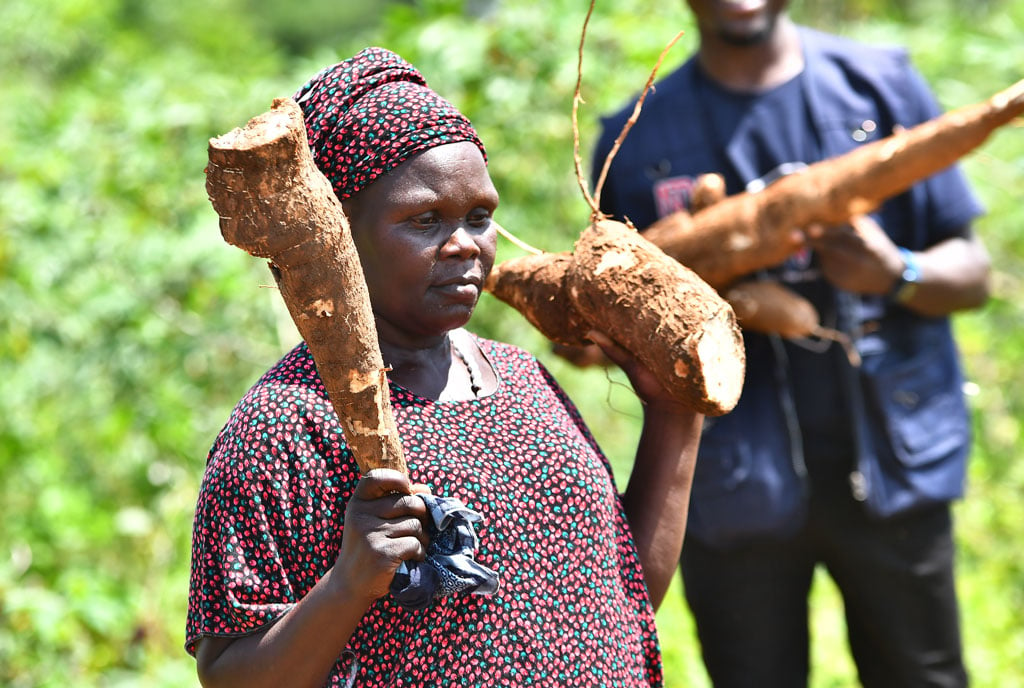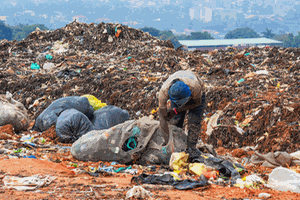
Empty plastic bottles can be used to protect soil for vegetable farming. PHOTO | MICHAEL J. SSALI
The farm is a source of food where milk, eggs, meat, and food crops such as beans, maize and cassava are produced. Farmers must, therefore, be conscious of sanitation in their daily activities to avoid food contamination and the spread of disease.
In addition, farmers are expected to keep in mind climate change mitigation and avoid activities that have tragic effects on farming. If global warming continues unabated, it will be impossible for most farmers, especially in poor countries, to practice agriculture.
The farm has to be well planned according to the different enterprises carried out on it and how farm waste is to be handled. There ought to be a place allocated to each activity; where milking is done, where grain is kept, where fodder and feeds are stored, and an area for manure heaps as well as all other farm waste disposal. Farm waste should be in separate containers in the form of plastics and hard metal, according to experts.
When we speak about climate change or global warming, some people mainly think about the burning of fossil fuels, oil, coal, and gas, as the main and only drivers of greenhouse gas emissions. Carbon dioxide is only one of the global warming gases.
Scientists say carbon dioxide forms a tiny proportion of the atmosphere but it is critical for maintaining the temperature in which life flourishes.
“Released into the atmosphere, carbon dioxide remains there for around 100 years,” says a PANOS Institute publication (www.panos.org.uk).
“This causes the atmosphere to retain more of the infrared heat radiated from the earth’s surface, thus leading to a gradual rise in global temperature,” it adds.
Cutting down or burning trees and forests, which absorb carbon dioxide, makes the situation worse. Planting more trees and preserving existing forests mitigate climate change.
The other global warming gases are methane and nitrous oxide which are mainly released by agricultural activities, and this is the reason farmers are expected to play a leading role in climate change mitigation.
Heaps of livestock dung or other forms of biodegradable waste emit the gas methane, which is said to be more potent than carbon dioxide. When released into the atmosphere, it remains there for 12 years, according to the PANOS Institute.
Dr Eseri Nankya, a soil scientist working with the National Agricultural Research Organisation (Naro), says farmers should avoid open exposure to livestock excreta and other organic matter waste for too long.
She recommends burying the organic waste such as dry grass or weeds into the soil (plough it into the soil) as the farmers carry out ground preparation.
The Naro official also says open disposal of garbage in landfills is a big climate change risk and discourages the burning of dry weeds and other organic materials despite the reported fertility of the soil where the burning has taken place.
“That is a short-term benefit but it is always better to plough back that waste into the soil...Burning of some of that rubbish results in the formation of such gases as nitrous oxide and it does not help in climate change mitigation,” Dr Nankya says.
She explains that it is also good practice to use organic material waste for making trash lines across gardens to fight soil erosion and improve soil fertility.
Dr Nankya suggests that farmers can use grass and green leaves to make compost manure by digging three pits and dropping them into one pit for some three weeks and into another at a three-week interval.
“The compost manure should immediately be ploughed into the soil and not kept exposed for too long,” she says.
“Another good practice would be to learn to make biochar[a charcoal-like product made from biomass waste, such as wood or agricultural waste or other biological residues], a skill that can be taught to the farmers by agricultural services extension workers,” Dr Nankya adds.
The Naro official is also of the view that the culture of waste disposal should be inculcated among young children right from primary school. She thinks that waste management should be part of the school curriculum along with tree planting so that people take the issue very seriously right from childhood.
Dr Edgar Basaliza, a senior environment specialist at Naro, describes farm waste as any unwanted material on the farm. He, however, points out that not all waste on the farm is unwanted.
“Some waste material is actually a resource; take, for example, coffee husks and other crop leftovers. They are manure and they can be used to improve soil fertility. What used to be waste long ago can now be put to very good use, thanks to recent technological innovations. We have to categorise the types of waste material on the farm and they have to be placed separately,” Dr Basaliza says.
“Some biodegradable materials such as tree leaves or dry weeds can be used to make items such as briquettes for cooking as alternatives to firewood, and they can also be turned into animal and fish feeds. We have non-biodegradable waste such as polythene waste, which may take decades to rot. Plastic bottles can stay for over a hundred years,” he adds.
Dr Basaliza says when plastic material stays in a place for a long time, it becomes a big environmental hazard with negative effects on human and animal health, including emissions of ammonia, methane and nitrous oxide especially when burnt. He says some of them contain herbicides and pesticides, which destroy soil micro-organisms that are vital for humus formation.
He says it is important for farmers to carry out what he referred to as the three Rs, which are; reduce the usage of synthetic containers, reuse plastic containers and recycle.
Dr Basaliza says farmers can get into contact with buyers of plastic waste and earn some money and that they should be vigorous in the general plastic waste material collection. “They must not let plastic materials go into rivers, swamps, and lakes,” he says, adding:“They must not be swallowed or eaten by animals.”
Climate change effects are already with us in Uganda and everybody must be concerned. On May 21, 2014, the Daily Monitor carried a photograph of a woman in Karamoja climbing a tree to get wild fruits to feed her family. A few weeks before, NTV Uganda had filmed graves of people who had died of starvation in the sub-region.
According to some reports, an estimated 50 people died in the dry period. Around that time in western Uganda, River Nyamwamba burst its banks due to excessive rain and the resulting flooding displaced hundreds of families and caused untold destruction, including damaging a hospital and a few schools.
Experts say such areas are experiencing extreme and unpredictable weather conditions and that river bridges keep collapsing here and there due to floods.
They add that long severe droughts are making it harder to grow crops. As a result, the climate is changing and our only hope seems to lie in climate change mitigation.
Uganda's hazard report
Scattered rains experienced during the months of June and July 2024 triggered flash floods and heavy storms. Lightning was reported in the Karamoja region in Amudat district, land conflicts in Wakiso and Amuru while public riots were recorded in Kamwenge District.
The hazards affected 12,446 individuals, with 1,989 people from 540 households internally displaced.
Adults between 18 and 64 years were the most affected age group (48 percent), followed by children below the age of 18 (39 percent) and elderly above 64 (13 percent). Notably, more than half of affected people were female (55 percent).
Infrastructure damage was significant, with 231 houses completely destroyed, 150 houses partially damaged, and 69 water facilities,nine schools and eight health facilities affected. Source: International Organisation for Migration (IOM), June - July 2024


